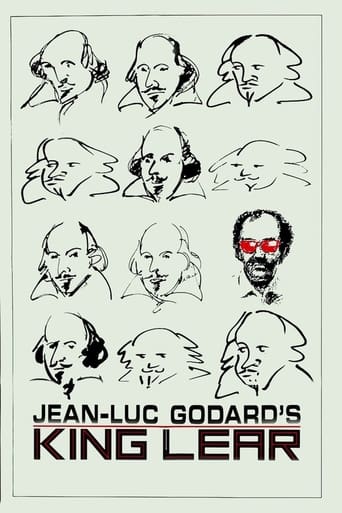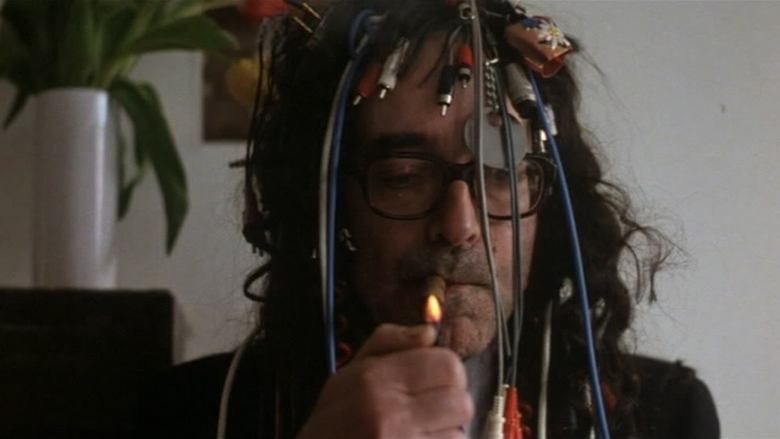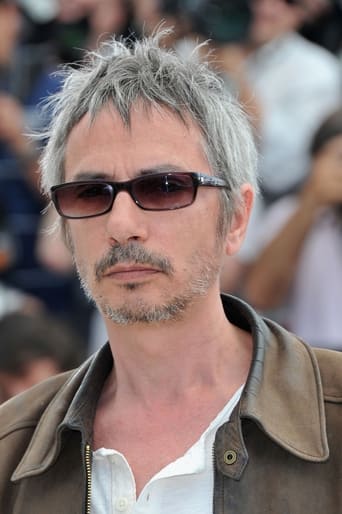

King Lear (1987)
A descendant of Shakespeare tries to restore his plays in a world rebuilding itself after the Chernobyl catastrophe obliterates most of human civilization.
Watch Trailer
Cast


Reviews
This is How Movies Should Be Made
Simply Perfect
it is the rare 'crazy' movie that actually has something to say.
The movie's neither hopeful in contrived ways, nor hopeless in different contrived ways. Somehow it manages to be wonderful
Everything returns to normal after Chernobyl. That is, everything but art. Most of the great works are lost, and it is up to people like William Shakespeare Junior the Fifth to restore the lost artwork of the human race. He finds strange goings-on at a resort enough to remind him of all the lines of the play, dealing with mob boss Don Learo and his daughter Cordelia, a strange professor named Jean Luc-Godard, who repeatedly xeroxes his hand for no particular reason.I gave this film a low rating primarily because of the way I saw it, with a low quality of picture and sound. I think there is a lot of potential here, but I wasn't fully able to enjoy it. Oddly, I don't think any people have seen this film, despite the names involved. Woody Allen? Norman Mailer? Molly Ringwald? This should be a cult classic. Has it received a proper release?
This film is absolutely brilliant. Weird characters and the fact that there's NO-THING really going on made this film interesting for me. Other people might find this film pointless and totally boring, but for me it's a treasure. I don't know anything about Shakespeare's 'King Lear' so I can't say if this film has anything to do with the actual play at all. This is exactly the kind of film that makes you think. After seeing this film you wonder what did the director want to tell me? Because clearly this film is made to communicate with the audience, it's an expression of the film maker's ideas, views and emotions. Or in other words... IT'S ART! The same goes to another Godard film 'Numero Deux'.
I have watched this film perhaps 100 times, and many of those times I feel as if I am watching it for the first time. It is incredibly rich.Quite a bit of philosophical sophistication is presupposed, so let's start with some basics. When Plato says that what you hear does not come from what you see he is perfectly correct. The colors that are produced in your mind by a message from your optic nerve do not cause the sounds that you hear. The green is not in the grass, only in your mind. The grass absorbs various radio waves, and your eye picks up on the unabsorbed reflected waves. The green is your body's miraculous way of letting you know about the radio waves around you. You are actually experiencing a series of still pictures, approximately 24 per second. If they were significantly faster than that, you would experience a movie as a series of still pictures. You are active in this process, because you organize the raw sensations. This can be seen in a gestalt shift.In everyday experience we are isolated people. All we relate to are the images that are in our minds. Zen Buddhists think we can have direct contact with the mysterious outside reality--not merely contact with images that those objects helped produced (satori). Godard is concerned with satori, but he is also concerned with experiencing the projector of the series of still pictures that he is experiencing. Your mind is working incredibly hard organizing everything you are experiencing 24 times a second. The incredible amount of organization it takes for you to read this sentence is but a small fraction of what your mind has just done.If a child were very bored with a movie, he might look around and see that it all comes from this light in the back of the room. If you had no interest in the images thrown up on your private movie screen by the ground of your being, perhaps you too could turn around and experience this projector. I take the projector to be Atman. Brahman (which I take to be the same as nirvana) would be actually going into the projection room. This is what they are trying to do in the movie theater. But (Oh no!)they are not innocent, and we get caught up with these images (which together their relationship to other images Kant calls reality); they are like the child who is too interested in the movie to look around.Now it is like choosing the first fruit from a cornucopia. I had some understanding of the ending this time, so let's start there. Here comes the spoiler: a seagull calls. It is trying to make it's presence known for some reason or other. We experience merely the result of a message from the nerve from our ear. It significance is just that: it's merely in our minds, but it comes from an outside reality that is trying to makes its presence known. It is part of the world that is not mere representation. That world (sacred to Godard) is really out there. The movie ends with that reminder.The visual image at the end is merely the words: King Lear A Study. Godard is saying that he has figured out something about King Lear. What that might be is indicated by the preceding lines read by a female voice: "Lend me a looking glass, if that her breath will mist or stain the stone, why then she lives." A looking glass presents images that are recognized as images. Lear is hoping against hope that Cordelia is still alive. He would have been satisfied if she could have heaved her heart into her mouth, if the unseen reality could become manifest to him. But now there might be something that is not a mere image on the looking glass--the mist or stain. This mist would represent Cordelia's life. Of course it is just a representation or image of her life, but for Godard their are images and images. An image is strong (which means that it has greater emotive force) if the association of ideas is distant and true. The opposite of this would be a flat image, as if perspective had been abolished. When Godard goes back and forth between images that tend to merge into each other, we are relating to them as two dimensional. Cordelia could not heave her heart into her mouth, but if Lear had been perceptive her silence could have shown him about her inner reality. The mist on the stone would show her that she lives, and would thus have strong emotive force. He could relate to her inner reality through the representation.It is not Lear's voice that reads the lines at the very end of the film, but the same resonant female voice that is associated with the symbolism of the white horse. The horse would be the emotion that finds its occasion in the strong image. There is something within us that wants to break out of our isolation and rises to the occasion when an opportunity to do so presents itself. This wholehearted response to an image allows me to be without reservation, and thus for my solitude to know yours (satori).Right before that we have Lear saying "She is as dead as earth." This corresponds to the image of Lear with Cordelia's dead body looking out at the source of the waves. The pebbled shore would be the private movies screen with its many objects. The waves would be the 24 times a second movement that throws itself onto the movie screen. Lear is not letting death defeat him. He's using the emotive power of her death to try to succeed to turn toward the projector. Wait Cordelia. The earthly reality is not the only reality, and he would relate to that reality that now has Cordelia.
This is a strange film, but a likable one. It asks the question: what would we do if all the great works of literature were suddenly lost? In a way, this is Jean-Luc Godard"s "Wasteland": in a manner not unlike the T.S. Eliot poem, Godard fills his work with quotes, allusions, and sometimes outright plagiarisms of his favorite works of art, literature, and film, including hommages to Robert Bresson's "Trial of Joan of Arc" and Grigori Kozintsev's "King Lear"; there's even a character named Kozintsev in the movie. Godard is not making a movie based on Shakespeare's "King Lear": he's making a movie about "King Lear." Godard has always considered himself an essayist rather than a storyteller, and the frequent use of captions, stills, and other distancing devices are reminiscent of his hero Bertold Brecht. Marxist rhetoric, though not absent, is less strident here than in some of Godard's earlier works. The movie is fun if occasionally irritating and often incomprehensible. Of the international cast, Molly Ringwald gives a touching performance as Cordelia, conveying much of her character's anguish through body language alone; Burgess Meredith reads Lear's lines with authority, and one wonders how he would have measured up in a more traditional interpretation of the play. The film hints at father-daughter incest, but there's no overt sexuality.




